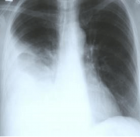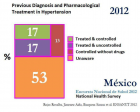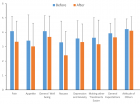Abstract
Research Article
Impact of four obesity interventions on biometric measures of individuals positive and negative for food addiction
Trina Aguirre*, Leeza Struwe, Ann Koehler, Rebecca Kreman, Rebecca Bowman, Erica Schulte, Kayla Pierce, Molly Bloodgood and effrey Holloway
Published: 28 September, 2018 | Volume 2 - Issue 1 | Pages: 001-0005
Obesity is a major contributor to ill health and numerous comorbidities globally. Recent studies suggest that addictive-like tendencies toward foods, especially highly processed foods, contribute to this epidemic. Therefore, interventions used to treat substance-use disorders may be effective for treating overweight/obese patients with food addiction (based on the Yale Food Addiction Scale, version 2.0). This pilot study evaluated four interventions, selected because of their effectiveness in the treatment of substance-use disorders [motivational interviewing, pharmacotherapy (naltrexone-bupropion), pharmacotherapy with motivational interviewing, information control (diet and physical activity instruction)], in overweight/obese individuals with and without food addiction. The food addiction construct identified a distinctive subset of overweight/obese individuals. Through one month, response to interventions differed between food addiction phenotypes with those who were positive for food addiction showing similar or less response to the interventions than those who were negative for the trait. This suggests that individuals with addictive-like tendencies toward food may require longer and more intensive intervention to achieve their goals. The greatest changes in biometric measures occurred between baseline and 1 month during which time participants were attending weekly intervention sessions. Across all groups, those who attended more sessions (dose) was correlated with a reduction in body mass index.
Read Full Article HTML DOI: 10.29328/journal.apmh.1001002 Cite this Article Read Full Article PDF
References
- WHO, 2017; Obesity fact files. Ref.: https://goo.gl/BqP4B9
- Schulte EM, Avena NM, Gearhardt AN. Which foods may be addictive? The roles of processing, fat content, and glycemic load. PLoS One. 2015; 18; 10: e0117959. Ref.: https://goo.gl/7kze2Q
- Flint AJ, Gearhardt AN, Corbin WR, Brownell KD, Field AE, et al. Food-addiction scale measurement in 2 cohorts of middle-aged and older women. Am J Clin Nutr. 2014; 99: 578-586. Ref.: https://goo.gl/QjQjCh
- Iozzo P, Guiducci L, Guzzardi MA, Pagotto U. Brain PET imaging in obesity and food addiction: current evidence and hypothesis. Obes Facts. 2012; 5: 155-164. Ref.: https://goo.gl/Xd7sjQ
- Pursey KM, Stanwell P, Gearhardt AN, Collins CE, Burrows TL. The prevalence of food addiction as assessed by the Yale Food Addiction Scale: a systematic review. Nutrients. 2014; 6: 4552-4590. Ref.: https://goo.gl/HVUP9u
- Gearhardt AN, Corbin WR, Brownell KD. Preliminary validation of the Yale food addiction scale. Appetite. 2009; 52: 430-436. Ref.: https://goo.gl/TN9UCR
- Gearhardt AN, Roberto CA, Seamans MJ, Corbin WR, Brownell KD. Preliminary validation of the Yale Food Addiction Scale for children. Eat Behav. 2013; 14: 508-512. Ref.: https://goo.gl/tyAffZ
- Imperatori C, Innamorati M, Contardi A, Continisio M, Tamburello S, et al. The association among food addiction, binge eating severity and psychopathology in obese and overweight patients attending low-energy-diet therapy. Comprehensive psychiatry. 2014; 55: 1358-1362. Ref.: https://goo.gl/CiqrSb
- Aguirre T, Bowman RB, Kreman R, Holloway J, LaTowsky J, et al. Pre-intervention characteristics in weight loss participants scoring positive and negative for food addiction. 2018. Oatext.com. Ref.: https://goo.gl/fcvgRx
- Lennerz B, Lennerz JK. Food Addiction, High-Glycemic-Index Carbohydrates, and Obesity. Clin Chem. 2018; 64: 64-71. Ref.: https://goo.gl/VKu5Vz
- Steward T, Mestre‐Bach G, Vintró‐Alcaraz C, Lozano‐Madrid M, Agüera Z, et al. Food addiction and impaired executive functions in women with obesity. European Eating Disorders Review. 2018; Ref.: https://goo.gl/sk8CDV
- Gearhardt AN, Corbin WR, Brownell KD. Development of the Yale Food Addiction Scale Version 2.0. Psychology of Addictive Behaviors. 2016; 30: 113-121. Ref.: https://goo.gl/97KDiU
- Miller WR. Motivational interviewing with problem drinkers. Behavioural and Cognitive Psychotherapy. 1983; 11: 147-172. Ref.: https://goo.gl/NPQvZZ
- Tober G. Motivational Interviewing and Behaviour Change in Addiction Treatment. Textbook of Addiction Treatment: International Perspectives. 2015; 779-7791. Ref.: https://goo.gl/y5Spsp
- Aguirre T, Koehler A, Wilhelm S. Bio-Impedance Analysis Measures in a Rural Latina Community. Journal of Public Health. 2014; 3:1-3. Ref.: https://goo.gl/vvhDA7
- Emmons KM, Rollnick S. Motivational interviewing in health care settings: opportunities and limitations. American journal of preventive medicine. 2001; 20: 68-74. Ref.: https://goo.gl/UuykAe
- Lobmaier PP, Kunøe N, Gossop M, Waal H. Naltrexone depot formulations for opioid and alcohol dependence: a systematic review. CNS neuroscience & therapeutics. 2011; 17: 629-636. Ref.: https://goo.gl/tDeCvH
- Richmond R, Zwar N. Review of bupropion for smoking cessation. Drug Alcohol Rev. 2003; 22: 203-220. Ref.: https://goo.gl/jbPpNi
- Caixàs A, Albert L, Capel I, Rigla M. Naltrexone sustained-release/bupropion sustained-release for the management of obesity: review of the data to date. Drug Des Devel Ther. 2014; 8: 1419-1427. Ref.: https://goo.gl/22qx1w
- Finelli C, Tarantino G. Have guidelines addressing physical activity been established in nonalcoholic fatty liver disease? World journal of gastroenterology: WJG. 2012; 18: 6790-6800. Ref.: https://goo.gl/aBLACz
- Freedman DS, Khan LK, Serdula MK, Ogden CL, Dietz WH. Racial and ethnic differences in secular trends for childhood BMI, weight, and height. Obesity (Silver Spring). 2006; 14: 301-308 Ref.: https://goo.gl/JmuT8f
- Griffiths C, Gately P, Marchant PR, Cooke CB. Cross‐sectional comparisons of BMI and waist circumference in British children: mixed public health messages. Obesity (Silver Spring). 2012; 20: 1258-1260. Ref.: https://goo.gl/5eh9q8
Similar Articles
-
Comparison of Cardiovascular Risks following Smoking Cessation Treatments Using Varenicline vs. NRT among Schizophrenic SmokersSusan Abughosh*,I-Hsuan Wu,Hua Chen,Ekere James Essien,Michael Johnson,Patrick Bordnick2,Ronald J Peters. Comparison of Cardiovascular Risks following Smoking Cessation Treatments Using Varenicline vs. NRT among Schizophrenic Smokers. . 2017 doi: 10.29328/journal.apmh.1001001; 1: 001-010
-
Impact of four obesity interventions on biometric measures of individuals positive and negative for food addictionTrina Aguirre*,Leeza Struwe,Ann Koehler,Rebecca Kreman,Rebecca Bowman,Erica Schulte,Kayla Pierce,Molly Bloodgood,effrey Holloway. Impact of four obesity interventions on biometric measures of individuals positive and negative for food addiction. . 2018 doi: 10.29328/journal.apmh.1001002; 2: 001-0005
-
Psychosocial care is necessary in supporting refugeesGudrun Widders*,Ute Teichert. Psychosocial care is necessary in supporting refugees. . 2018 doi: 10.29328/journal.apmh.1001003; 2: 006-008
-
Mental health promotion program in the workplace with focus on transportOlaf Jensen*,Fereshteh Baygi,George Charalambous,Agnes Flores,Lise Hedegaard Laursen,David Lucas,Debbie Andrioti. Mental health promotion program in the workplace with focus on transport. . 2019 doi: 10.29328/journal.apmh.1001004; 3: 001-011
-
Diseases of the mental sphere revealed by the psychiatrist at contingent of patients of the consultative outpatient admissionShapovalova LA*,Shapovalov КA. Diseases of the mental sphere revealed by the psychiatrist at contingent of patients of the consultative outpatient admission. . 2019 doi: 10.29328/journal.apmh.1001005; 3: 012-019
-
Cognition and Memory Impairment among Patients of Depression in Pakistan-The Role of Conventional and Newer Anti-DepressantsMadeeha Malik*,Muhammad Usama Khan,Azhar Hussain,Ayisha Hashmi. Cognition and Memory Impairment among Patients of Depression in Pakistan-The Role of Conventional and Newer Anti-Depressants. . 2019 doi: 10.29328/journal.apmh.1001006; 3: 020-024
-
Effectiveness of ethinyl oestradiol /cyproterone acetate and ethinyl oestradiol/ desogestrel with or without low-dose metformin on perceived health-related quality of life in hirsute women with polycystic ovary disease: A randomised, double-blind, placebo-controlled studySanjeewani Fonseka*,B Subhani,V Alahakoon,CN Wijeyaratne,IB Gawarammana,NS Kalupahana,N Ratnatunga,S Rosairo,PVR Kumarasiri. Effectiveness of ethinyl oestradiol /cyproterone acetate and ethinyl oestradiol/ desogestrel with or without low-dose metformin on perceived health-related quality of life in hirsute women with polycystic ovary disease: A randomised, double-blind, placebo-controlled study. . 2019 doi: 10.29328/journal.apmh.1001007; 3: 025-031
-
A Belgian program to fight child maltreatment: The “SOS children” teamsSophie Dechêne*,Emmanuel de Becker. A Belgian program to fight child maltreatment: The “SOS children” teams. . 2019 doi: 10.29328/journal.apmh.1001008; 3: 032-041
-
Microchimerism may be the cause of psychiatric disordersOsman Demirhan*,Bülent Demirbek. Microchimerism may be the cause of psychiatric disorders. . 2019 doi: 10.29328/journal.apmh.1001009; 3: 042-046
-
Transference and countertransference are linked to placebo-nocebo effects and they are an auxiliary resource of unparalleled value in general medicine: Recommendations for general practitionersJose Luis Turabian*. Transference and countertransference are linked to placebo-nocebo effects and they are an auxiliary resource of unparalleled value in general medicine: Recommendations for general practitioners. . 2020 doi: 10.29328/journal.apmh.1001010; 4: 001-006
Recently Viewed
-
Outpatient operative hysteroscopy: evaluation of patient satisfaction and acceptanceClare Margaret Crowley*,Noelle Gill,Minna Geisler. Outpatient operative hysteroscopy: evaluation of patient satisfaction and acceptance. Clin J Obstet Gynecol. 2022: doi: 10.29328/journal.cjog.1001098; 5: 005-008
-
Predictors of positive treatment response to PTNS in women with overactive bladderSuneetha Rachaneni*,Doyo Enki,Megan Welstand,Thomasin Heggie,Anupreet Dua. Predictors of positive treatment response to PTNS in women with overactive bladder. Clin J Obstet Gynecol. 2022: doi: 10.29328/journal.cjog.1001097; 5: 001-004
-
Prediction of neonatal and maternal index based on development and population indicators: a global ecological studySedigheh Abdollahpour,Hamid Heidarian Miri,Talat Khadivzadeh*. Prediction of neonatal and maternal index based on development and population indicators: a global ecological study. Clin J Obstet Gynecol. 2021: doi: 10.29328/journal.cjog.1001096; 4: 101-105
-
A Genetic study in assisted reproduction and the risk of congenital anomaliesKaparelioti Chrysoula,Koniari Eleni*,Efthymiou Vasiliki,Loutradis Dimitrios,Chrousos George,Fryssira Eleni. A Genetic study in assisted reproduction and the risk of congenital anomalies. Clin J Obstet Gynecol. 2021: doi: 10.29328/journal.cjog.1001095; 4: 096-100
-
Leiomyosarcoma in pregnancy: Incidental finding during routine caesarean sectionToon Wen Tang*,Phoon Wai Leng Jessie. Leiomyosarcoma in pregnancy: Incidental finding during routine caesarean section. Clin J Obstet Gynecol. 2021: doi: 10.29328/journal.cjog.1001094; 4: 092-095
Most Viewed
-
Evaluation of Biostimulants Based on Recovered Protein Hydrolysates from Animal By-products as Plant Growth EnhancersH Pérez-Aguilar*, M Lacruz-Asaro, F Arán-Ais. Evaluation of Biostimulants Based on Recovered Protein Hydrolysates from Animal By-products as Plant Growth Enhancers. J Plant Sci Phytopathol. 2023 doi: 10.29328/journal.jpsp.1001104; 7: 042-047
-
Sinonasal Myxoma Extending into the Orbit in a 4-Year Old: A Case PresentationJulian A Purrinos*, Ramzi Younis. Sinonasal Myxoma Extending into the Orbit in a 4-Year Old: A Case Presentation. Arch Case Rep. 2024 doi: 10.29328/journal.acr.1001099; 8: 075-077
-
Feasibility study of magnetic sensing for detecting single-neuron action potentialsDenis Tonini,Kai Wu,Renata Saha,Jian-Ping Wang*. Feasibility study of magnetic sensing for detecting single-neuron action potentials. Ann Biomed Sci Eng. 2022 doi: 10.29328/journal.abse.1001018; 6: 019-029
-
Pediatric Dysgerminoma: Unveiling a Rare Ovarian TumorFaten Limaiem*, Khalil Saffar, Ahmed Halouani. Pediatric Dysgerminoma: Unveiling a Rare Ovarian Tumor. Arch Case Rep. 2024 doi: 10.29328/journal.acr.1001087; 8: 010-013
-
Physical activity can change the physiological and psychological circumstances during COVID-19 pandemic: A narrative reviewKhashayar Maroufi*. Physical activity can change the physiological and psychological circumstances during COVID-19 pandemic: A narrative review. J Sports Med Ther. 2021 doi: 10.29328/journal.jsmt.1001051; 6: 001-007

HSPI: We're glad you're here. Please click "create a new Query" if you are a new visitor to our website and need further information from us.
If you are already a member of our network and need to keep track of any developments regarding a question you have already submitted, click "take me to my Query."


















































































































































